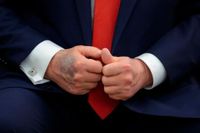On Monday, August 25, 2025, President Donald Trump met with South Korean President Lee Jae Myung in the Oval Office. While the diplomatic encounter itself might have been routine, it was the president’s hands—specifically, a large, black-and-blue bruise on his right hand—that drew the nation’s gaze. The bruise, clearly visible in official photographs, quickly became a lightning rod for speculation, igniting a fresh round of questions about the president’s health and the White House’s transparency.
Just three days earlier, Trump’s right hand had been covered with a thick splotch of makeup that didn’t quite match his skin tone, as reported by the Associated Press. The attempt at concealment only fueled the curiosity. To add to the intrigue, a similar bruise had recently appeared on his left hand. For a man who, at 79, is the oldest person inaugurated as U.S. president, these visible signs of injury have taken on outsized significance—especially in a political climate where every detail is scrutinized and spun.
White House press secretary Karoline Leavitt attempted to quell the rumors, stating that the bruising was “consistent” with irritation from Trump’s “frequent handshaking and the use of aspirin.” She echoed the assessment of White House physician Dr. Sean Barbabella, who had previously written that the bruises were “consistent with minor soft tissue irritation from frequent handshaking and the use of aspirin, which is taken as part of a standard cardiovascular prevention regimen.”
But the public wasn’t buying it—not entirely, at least. Social media erupted with skepticism. The anti-Trump media group MeidasTouch tweeted, “Release the health records.” Influencer David Pakman quipped, “They want us to believe that Trump has bruises on BOTH HANDS from handshaking with his right hand, but his ear healed so perfectly after being shot that there was NO SIGN of it within weeks. Got it.” Joanne Carducci, known online as JoJofromJerz, added, “If Joe Biden’s hand had looked like it was covered in grey scale Fox would be running that s--- on a loop 24/7.”
According to Newsweek, the president’s health has been under a microscope for some time. In a May 2025 poll, 45 percent of respondents said Trump had been “not at all” or “not very” transparent about his health. In July, more than 8,000 people signed a petition demanding the release of all his medical records. As new photos of the president’s bruised hands circulated, the White House released a memo explaining that Trump had been diagnosed with chronic venous insufficiency (CVI), a condition described by Dr. Barbabella as “benign and common, especially among individuals over the age of 70.”
Dr. Barbabella’s letter, shared with the press in July, stated that comprehensive tests had been performed and that “there was no evidence of arterial disease or deep vein thrombosis (DVT).” He emphasized, “President Trump remains in excellent health.” The White House Medical Unit, according to Barbabella, had thoroughly evaluated the concern “out of an abundance of caution.”
So what exactly is chronic venous insufficiency? The National Institutes of Health describes CVI as a prevalent condition, affecting about 150,000 new individuals annually in the United States. It occurs when incompetent venous valves allow blood to pool in the veins, leading to symptoms such as swelling, pain, and, yes, bruising. If left untreated, CVI can diminish quality of life, reduce work productivity, and even lead to more severe complications like venous ulcers. The NIH notes that the condition is “usually progressive” and can result in postphlebitic syndrome, a complication of deep vein thrombosis that causes lasting damage.
Despite these reassurances, the optics of a president with recurring, unexplained bruises have proven difficult to manage. According to Forbes, the bruising on Trump’s hand was first noticed months ago, and the White House’s initial response was to cover it with foundation. But as the marks persisted—and as the president’s public appearances continued—concealment gave way to a more direct approach. The makeup was gone by August 25, revealing the dark bruises in full view. The administration’s explanations evolved from makeup mishaps to medical memos, but the underlying issue—public distrust—remained stubbornly in place.
Some of the skepticism stems from the broader context of presidential health disclosures. As Newsweek noted, the White House’s handling of the situation has been likened to a “branding crisis” by some social media commentators. One user, @Xray_media, wrote, “The admin treats presidential health like a branding crisis, applying concealer to inconvenient truths. The official story? ‘Vigorous handshaking.’ Apparently, democracy is now a full-contact sport.” The user went on to criticize the lack of direct access to Dr. Barbabella, suggesting that the absence of the physician from public questioning only adds to the distrust.
Trump himself has downplayed the concerns. In a December 2024 interview with Time, he attributed the bruises to his habit of “shaking hands with thousands of people.” Still, the visible evidence has proved hard to ignore. The president was photographed with a smaller bruise on his left hand and a notable patch of makeup on his right hand while visiting the People’s House museum in Washington, D.C. on August 22. Three days later, during his meeting with President Lee, the bruise on his right hand covered the majority of the back of his hand.
For many Americans, the issue isn’t the bruise itself—it’s the trust deficit. As Stephen Mutoro put it on social media, “The question isn’t the bruise—it’s the trust deficit.” The administration’s shifting explanations, combined with the president’s age and history of health-related scrutiny, have made the public especially sensitive to any signs of obfuscation or spin.
Medical experts, meanwhile, have largely echoed the White House’s line. CVI is indeed common among older adults, and the use of aspirin as a cardiovascular preventive is routine. The fact that comprehensive tests found no evidence of more serious conditions such as arterial disease or DVT offers some reassurance. But in the age of viral images and instant commentary, even benign medical explanations can fall flat if they aren’t paired with a sense of openness and candor.
As the 2024 election cycle heats up and President Trump continues to occupy the world’s most visible stage, the scrutiny over his health is unlikely to fade. The bruises may heal, but the questions—and the skepticism—are sure to linger. For now, the White House maintains that the president is in “excellent health.” Whether the public is convinced is another matter entirely.

